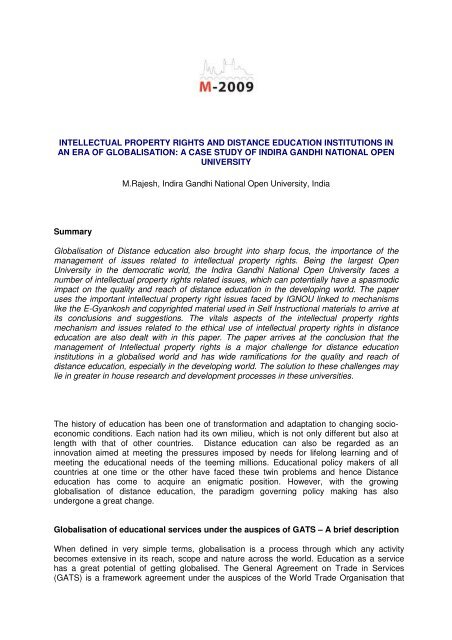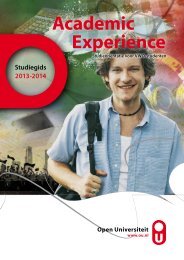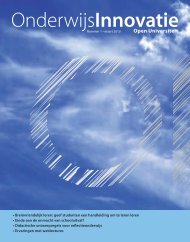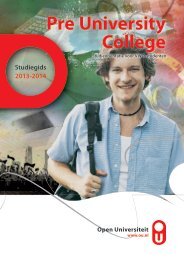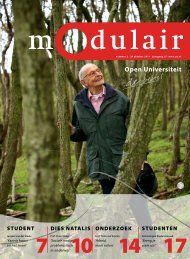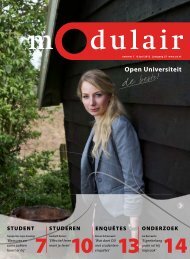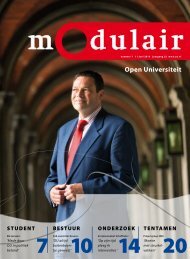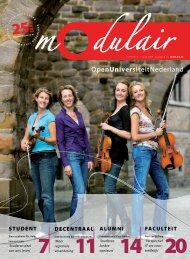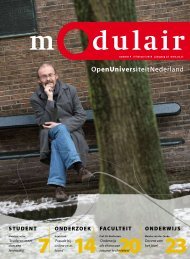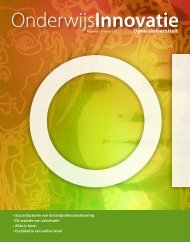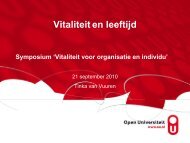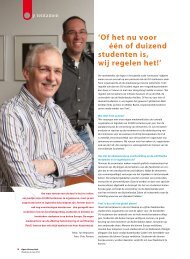intellectual property rights and distance education institutions
intellectual property rights and distance education institutions
intellectual property rights and distance education institutions
You also want an ePaper? Increase the reach of your titles
YUMPU automatically turns print PDFs into web optimized ePapers that Google loves.
INTELLECTUAL PROPERTY RIGHTS AND DISTANCE EDUCATION INSTITUTIONS IN<br />
AN ERA OF GLOBALISATION: A CASE STUDY OF INDIRA GANDHI NATIONAL OPEN<br />
UNIVERSITY<br />
M.Rajesh, Indira G<strong>and</strong>hi National Open University, India<br />
Summary<br />
Globalisation of Distance <strong>education</strong> also brought into sharp focus, the importance of the<br />
management of issues related to <strong>intellectual</strong> <strong>property</strong> <strong>rights</strong>. Being the largest Open<br />
University in the democratic world, the Indira G<strong>and</strong>hi National Open University faces a<br />
number of <strong>intellectual</strong> <strong>property</strong> <strong>rights</strong> related issues, which can potentially have a spasmodic<br />
impact on the quality <strong>and</strong> reach of <strong>distance</strong> <strong>education</strong> in the developing world. The paper<br />
uses the important <strong>intellectual</strong> <strong>property</strong> right issues faced by IGNOU linked to mechanisms<br />
like the E-Gyankosh <strong>and</strong> copyrighted material used in Self Instructional materials to arrive at<br />
its conclusions <strong>and</strong> suggestions. The vitals aspects of the <strong>intellectual</strong> <strong>property</strong> <strong>rights</strong><br />
mechanism <strong>and</strong> issues related to the ethical use of <strong>intellectual</strong> <strong>property</strong> <strong>rights</strong> in <strong>distance</strong><br />
<strong>education</strong> are also dealt with in this paper. The paper arrives at the conclusion that the<br />
management of Intellectual <strong>property</strong> <strong>rights</strong> is a major challenge for <strong>distance</strong> <strong>education</strong><br />
<strong>institutions</strong> in a globalised world <strong>and</strong> has wide ramifications for the quality <strong>and</strong> reach of<br />
<strong>distance</strong> <strong>education</strong>, especially in the developing world. The solution to these challenges may<br />
lie in greater in house research <strong>and</strong> development processes in these universities.<br />
The history of <strong>education</strong> has been one of transformation <strong>and</strong> adaptation to changing socioeconomic<br />
conditions. Each nation had its own milieu, which is not only different but also at<br />
length with that of other countries. Distance <strong>education</strong> can also be regarded as an<br />
innovation aimed at meeting the pressures imposed by needs for lifelong learning <strong>and</strong> of<br />
meeting the <strong>education</strong>al needs of the teeming millions. Educational policy makers of all<br />
countries at one time or the other have faced these twin problems <strong>and</strong> hence Distance<br />
<strong>education</strong> has come to acquire an enigmatic position. However, with the growing<br />
globalisation of <strong>distance</strong> <strong>education</strong>, the paradigm governing policy making has also<br />
undergone a great change.<br />
Globalisation of <strong>education</strong>al services under the auspices of GATS – A brief description<br />
When defined in very simple terms, globalisation is a process through which any activity<br />
becomes extensive in its reach, scope <strong>and</strong> nature across the world. Education as a service<br />
has a great potential of getting globalised. The General Agreement on Trade in Services<br />
(GATS) is a framework agreement under the auspices of the World Trade Organisation that
seeks to determine the rules of trade in services including trade in <strong>education</strong>al services. For<br />
the purpose of classification, the UN product classification system for <strong>education</strong>al services is<br />
adopted by GATS.<br />
GATS emphasizes both cross border barriers <strong>and</strong> barriers to local establishments without<br />
explicit preference to either, while the General Agreement on Trade <strong>and</strong> Tariffs (GATT) gives<br />
explicit preference to barriers at the borders like tariffs, Quota etc. GATS brings under its<br />
purview, any service in any sector, except those provided in exercise of Governmental<br />
Authority {GATS-Article13 (B)}. However, the text goes on to say that any service provided<br />
on a commercial basis or in competition with one or more service providers will also be under<br />
its ambit. This provision has major implications for the <strong>education</strong> sector.<br />
The major modes of supply under GATS as applicable to Distance <strong>education</strong> are presented<br />
below 1 :<br />
MODE1: It covers the aspect of Cross- Border Trade; this covers all those activities in which<br />
a producer exports a service from its own territory to a consumer in a foreign country. For<br />
example, an <strong>education</strong>al Institution in India provides an on-line <strong>education</strong>al programme to<br />
students in another country.<br />
MODE2: It pertains to consumption abroad. This takes care of all those cases where a<br />
consumer goes abroad to obtain a service. For example if a patient goes abroad for<br />
treatment or a student from one country visiting a foreign country to obtain a degree, it is a<br />
case of a service consumed abroad.<br />
MODE3: It covers within its ambit the aspect of commercial presence. This implies that a<br />
service provider from one country sets up business subsidiary or branches in another<br />
country. For example, if IGNOU establishes its branches in foreign countries, it indicates the<br />
commercial presence of IGNOU in that country.<br />
MODE4: It deals with the Movement of Natural Persons. In this case a member of the<br />
service-providing firm goes to the domestic territory of another country to provide a service<br />
there. Such movements are only for a short period of time. For Example, a Distance<br />
Learning institute of India sends its administrative officer to Dubai to manage the affairs of its<br />
branch there for a period of Five years.<br />
A brief description of Intellectual Property Rights with an impact on <strong>distance</strong> <strong>education</strong>:<br />
The commercialisation of the fruits of the intellect even in developing countries has been a by<br />
product of globalisation. This is true even in the field of <strong>education</strong>, especially <strong>distance</strong><br />
<strong>education</strong>. The most important of such Intellectual Property Rights are Patent Rights, Copy<br />
<strong>rights</strong> <strong>and</strong> related <strong>rights</strong>, <strong>rights</strong> related to trademarks etc.<br />
1. Patent Rights<br />
A patent for all purposes is a right conferred upon the inventor to put to use his invention or<br />
authorise another person or entity to use the same under agreed terms <strong>and</strong> conditions without<br />
infringing the established <strong>rights</strong> <strong>and</strong> privileges of the society. Such an invention should meet<br />
three general conditions<br />
1 www.wto.org
a. Non- Obviousness, which is, it should not be an obvious piece of work for anyone<br />
possessing an ordinary underst<strong>and</strong>ing of the field under question.<br />
b. Capable of industrial/ commercial application<br />
c. It should not be a general scientific principle<br />
If these conditions are satisfied a patent could be conferred on the practitioner.<br />
In an era when <strong>distance</strong> <strong>education</strong> <strong>institutions</strong> are crossing boundaries using any of the modes<br />
mentioned above, it is but natural that patent holder, their <strong>rights</strong> <strong>and</strong> uses acquires<br />
international connotations. Further, in the field of <strong>distance</strong> <strong>education</strong>, a number of patents<br />
come into play, especially in the field of computer software. Though it is generally accepted<br />
that the machine generated part of a computer programme is non patentable, the human<br />
generated part of a computer programme is definitely patentable. Therein lies the kernel of all<br />
problems. Generally, as far as software is concerned protection is provided to (Moreau 2008) 2<br />
• The source code of a programme<br />
• The machine code of the source code<br />
• The algorithm, that is the sequence of machine comm<strong>and</strong>s<br />
• The interface <strong>and</strong> the texture of the programme<br />
One of the high profile litigation in recent times is between Blackboard <strong>and</strong> Desire to Learn in<br />
2006. The issue emerged when Blackboard <strong>and</strong> WebCT merged in 2006. The newly merged<br />
concern sued Desire to Learn for the use of its patented algorithms 3 . Now this is a difficult<br />
issue for any <strong>distance</strong> <strong>education</strong> institution to work upon. A single computer programme at<br />
times may have numerous algorithms with in it <strong>and</strong> therefore the prospect of procuring <strong>rights</strong><br />
for each of these algorithms is indeed very difficult <strong>and</strong> costly. This is one of the instances<br />
where, there could be a negative impact on the delivery of <strong>distance</strong> <strong>education</strong> programmes.<br />
On the other h<strong>and</strong>, if in house research of these organisations is strong, much royalty could<br />
also be gained by these organisations by marketing their patents.<br />
2. Copy<strong>rights</strong> <strong>and</strong> Related Rights<br />
The copy<strong>rights</strong> subsume with in it a number of related <strong>rights</strong> also. For instance, when an<br />
<strong>education</strong>al CD is created by a <strong>distance</strong> <strong>education</strong> institution, a number of <strong>rights</strong> <strong>and</strong> <strong>rights</strong><br />
owners are simultaneously created. Let us have a look at some of them.<br />
• The academic who has given a script <strong>and</strong> academic input to the production has a<br />
right to protect his script an input<br />
• The composer who has given background music in the production has his <strong>rights</strong>,<br />
which are protected<br />
• The producer of the programme has protectable production related <strong>rights</strong><br />
• The director of the work has protectable directorial <strong>rights</strong><br />
• The institution that has commissioned the production of the programme has certain<br />
<strong>rights</strong> that can be protected.<br />
• Only reproduction of a work is prohibited, but use of ideas is not. This means that<br />
while a literature programme produced by an open university on the “Ten<br />
Comm<strong>and</strong>ments” per say is protected; the concept of “Ten Comm<strong>and</strong>ments” may<br />
be produced in a different form by another open university.<br />
2 Moreau, Nancy, “Is it ethical for patents to be issued for the computer algorithms that affect course<br />
management systems of Distance Learning?”, The American Journal of Distance Education., Vol.22, Number 4,<br />
Oct –Dec, 2008<br />
3 Ibid
So it can well be seen that under the omnibus term “copy<strong>rights</strong>” a number of <strong>rights</strong> are<br />
covered. From the point of view of a Distance <strong>education</strong> institution, copy<strong>rights</strong> perhaps form<br />
the most important of all <strong>intellectual</strong> <strong>property</strong> <strong>rights</strong>. It does not matter in cases where the<br />
material is already in the public domain, but where it is not the matter has to be protected.<br />
Under the Berne Convention, products of the intellect in the form of written work or<br />
phonograms have to be protected. In the present context, this can be exp<strong>and</strong>ed to include<br />
matter contained in websites, databases, television programmes <strong>and</strong> so on. All these types of<br />
<strong>intellectual</strong> <strong>property</strong> are of vital importance to <strong>distance</strong> <strong>education</strong>. More often than not<br />
infringements primarily occur with reference to such <strong>intellectual</strong> <strong>property</strong> <strong>rights</strong>. Reference<br />
may be made to a recent case in this regard. The owner of the website<br />
“worldwidelearn.com” claimed that another website- “<strong>distance</strong>learningsite.com” had<br />
infringed his copy right by copying verbatim the contents of his website 4 . The owner of<br />
worldwidelearn.com also claimed to be imposing a legal suit upon the infringer. The owner<br />
also dem<strong>and</strong>ed that the search engine Google should also remove the site from its search<br />
database to protect his <strong>rights</strong> 5 .<br />
3. Trademarks<br />
Trademarks are nomenclatures, designs, patterns, marks etc that aid a consumer in identifying<br />
a product with a br<strong>and</strong> or br<strong>and</strong> name. In terms of modern definitions, a trademark may not<br />
only a visible design, mark or pattern, but could also be a sound. The most famous of these is<br />
the voice mark of Yahoo. One of the cardinal tenets of all laws on trademarks is that these<br />
marks should not be adopted by a competitor in such a way that it confuses the consumer<br />
regarding rivalling br<strong>and</strong>s. Further, a trademark must not be the name of the product. For<br />
instance, we cannot have the name Distance Education for a <strong>distance</strong> <strong>education</strong> institution.<br />
Trademarks have been misused by quasi-business circles around the world. In <strong>distance</strong><br />
<strong>education</strong> such instances of misuse are even today very rare. This might be because most<br />
major <strong>distance</strong> <strong>education</strong> <strong>institutions</strong> are in the realm of the public sector <strong>and</strong> procedures for<br />
most part are streamlined.<br />
Patent <strong>rights</strong> <strong>and</strong> Distance Education – the case of IGNOU<br />
As with most other Distance Education <strong>institutions</strong>, the patents owned by IGNOU are very few<br />
in number. So for most of its service delivery requirements, it has to depend on sourced <strong>rights</strong><br />
that involve royalty payment. This is very true when it comes to the use of computer software<br />
as part of its study programmes as well as its delivery mechanism. Let us take the case of<br />
computer courses itself. The university uses a number of commercial software as part of its<br />
course input, be it oracle, windows or KOHA. All such software has to be brought at market<br />
price <strong>and</strong> a copy of software cannot be used in another even for <strong>education</strong>al purposes.<br />
Needless to state, this brings in a situation where only those <strong>institutions</strong> can be designated as<br />
learner support centres that possess authorised versions of such software. The objective of<br />
the university is to “reach the unreached” <strong>and</strong> such commercial restrictions prevent the<br />
dissemination of these <strong>education</strong>al programmes in rural areas. The instances in which some of<br />
the learner support centres had to be closed down due to non- availability of authorized/<br />
licensed software is not rare. Further, the university itself has a number of functions to be run<br />
on software based utilities. Such utilities have to be bought at commercial rates which are<br />
pretty steep. No wonder, some of the basic systems of the university still run on outdated<br />
platforms like D-Base, Fox-pro, Fox-Base <strong>and</strong> so on. This makes integration into new systems<br />
<strong>and</strong> the integration into online service provision mechanisms very difficult. The better<br />
alternative would have been to invest sufficiently in Research <strong>and</strong> Development <strong>and</strong> procure<br />
usable patents for the university so that dependence on costly patents would have been<br />
4 www.chillingeffects.org<br />
5 ibid
avoided. Further, migration to free software like Linux <strong>and</strong> acceptance of Moodle type<br />
mechanisms would have been very productive. Another interesting mechanism could have<br />
been cloud computing.<br />
So where does it leave IGNOU? Undoubtedly, patented software would continue to impose<br />
heavy burdens on the institution, if in house capability is not created to develop packages to<br />
suit institutional needs preferably using free software. Until such time, the costs of operation in<br />
IGNOU for software related programmes would continue to be high.<br />
Copy <strong>rights</strong>, related <strong>rights</strong> <strong>and</strong> IGNOU<br />
IGNOU is one of those universities in India that has a very clear cut policy when it comes to<br />
copy <strong>rights</strong> <strong>and</strong> related <strong>rights</strong>. The university has also instituted a scheme of severe penalties<br />
to anyone who circumvents the laws related to copy <strong>rights</strong>. The IPR laws with basic application<br />
to written material apply a great deal to the university, since the primary form of support<br />
service to students in IGNOU is even today the print material. When it comes to print material,<br />
the primary question that emerges is – “with whom does the copy right actually lie?” In a<br />
system as complex as IGNOU’s, the answer is not very simple. Prime facie, it may seem as if<br />
the copyright lies with the author. But, in IGNOU, all course material is written by a course<br />
team, though different chapters may be obtained from different individuals. In this case, the<br />
chapter <strong>rights</strong> may lie with individual authors. However, this is not a maximally defensible<br />
position, since the content provided by individual authors is reviewed <strong>and</strong> edited by a team of<br />
editors. The editors not only give suggestions regarding the direction of the chapter but also<br />
may include content that they deem as essential for the chapter. In this case should the copy<br />
right of the matter also rest with the editors? Further, every programme has a course<br />
preparation team, which gives extensive suggestions regarding the course content, level of the<br />
programme etc. Should their <strong>intellectual</strong> <strong>rights</strong> also be protected? It is true that once a chapter<br />
is prepared, the author has to transfer the copyright in favour of the university. But in the<br />
context mentioned above, is it his sole prerogative to transfer the copy right of the chapter?<br />
The university has embarked upon a policy of open access to its study material by creating a<br />
digital depository – the E- Gyan kosh. Most of the print material produced by IGNOU is<br />
deposited here in the digital form. Through this process the university aims at providing access<br />
to the latest study material to the general public at large. There in lies a problem of Moral<br />
Hazards as far as use of copyrighted material is concerned. The fact that a university like<br />
IGNOU would periodically update the E-Gyan kosh <strong>and</strong> also add fresh material to this<br />
depository which is freely available for use by other <strong>institutions</strong>, makes these <strong>institutions</strong> less<br />
sensitive to the need to develop their own material <strong>and</strong> exp<strong>and</strong> their focus on in house<br />
research. Further, IGNOU may also loose in the process. An excellent example would be the<br />
use of IGNOU material (like for MBA) by other <strong>institutions</strong> while relaxing the entry<br />
requirements <strong>and</strong> also by making the term end examinations less difficult in comparison to<br />
IGNOU. Therefore students would naturally flock to a number of these <strong>institutions</strong> instead of<br />
IGNOU. The enrolment figures of the Chennai Regional Centre of IGNOU in the state of Tamil<br />
Nadu are a case in view.<br />
Perhaps, it would be pertinent at this point to suggest that IGNOU should enforce a policy of<br />
charging discriminative royalty from such users. What is implied here is that the university<br />
would do well to follow the ability to pay principle. It is obvious that institutional users of copy<br />
righted material undoubtedly have the wherewithal to pay a higher level of royalty when<br />
compared to the students <strong>and</strong> therefore should be charged higher. Further the terms of use<br />
of such material should also be very clearly laid down. The use of such material should not<br />
harm the commercial interests of the university.<br />
Yet it is not true that the university has been spared of third party copy right issues. Recently,<br />
for instance, copyright issues came to the fore when certain representations in one of the
Health science programme study materials was contested as having third part copy right <strong>and</strong><br />
subsequently had to be removed. More such issues can be expected in future as the volume<br />
of the study material produced by the university is rapidly exp<strong>and</strong>ing to include the latest<br />
horizons of knowledge.<br />
Trademarks <strong>and</strong> related issues in the context of IGNOU<br />
The issues pertaining to trademarks are perhaps given least importance in IGNOU. This is<br />
perhaps due to the fact that they are the least noticeable among all IPR infringements.<br />
Another reason could be that trademarks resembling each other are often used by fraternal<br />
governmental <strong>institutions</strong> <strong>and</strong> are therefore not considered as infringements per say. Let us<br />
consider the logos of IGNOU <strong>and</strong> that of National Institute of Open Schooling. To the author,<br />
their logos seem very similar. Further, we should also underst<strong>and</strong> that they are in similar<br />
fields, IGNOU in the field of university <strong>education</strong> <strong>and</strong> NIOS in the field of open schooling. If<br />
both these organisations were operating in the private sector, the similarity of their logos<br />
could have created commercial difficulties.<br />
Trademarks could become a bone of contention in future when more <strong>and</strong> more <strong>institutions</strong><br />
would enter the market <strong>and</strong> compete among each other. As on date IGNOU has not<br />
emerged as a major competitor in the international field <strong>and</strong> therefore, the portends of the<br />
trademark issue are hardly noticed.<br />
Intellectual Property Rights <strong>and</strong> Ethical issues in the context of <strong>distance</strong> <strong>education</strong><br />
One of the major issues relates to ethics when we consider the enforcement of IPRs. The<br />
most important aspect to be considered here is as to how far should we go in enforcing IPRs<br />
<strong>and</strong> at which point common good should be considered as the guiding force over individual<br />
<strong>intellectual</strong> <strong>property</strong> <strong>rights</strong>. Needless to state, unless <strong>intellectual</strong> <strong>property</strong> <strong>rights</strong> are protected<br />
<strong>and</strong> rewarded, there will neither be inventions or innovations nor there masterpieces. On the<br />
other h<strong>and</strong>, these <strong>rights</strong> have to be balanced against common good. If a study material has<br />
very high dem<strong>and</strong> (like an essential reading), but its cost of production is also very high in<br />
terms of copyright charges, it makes sense for an university like IGNOU in collaboration with<br />
the government to put in public domain for the common good.<br />
While talking about Ethics in the context of software, Nancy Moreau 6 talks about three types<br />
of ethics.<br />
• Outcome Based Ethics, in which the end justifies the means. The end in this<br />
case is the greatest good of the greatest numbers. But Moreau contents that in<br />
the case of software patenting the greatest good of only the corporations was met<br />
but not the consumers.<br />
• Duty Based Ethics, which hinged upon the concept of right action. But the<br />
problem is that the concept of right action differs from person to person <strong>and</strong><br />
therefore, what might be right for a multinational computer corporation may not be<br />
right for a <strong>distance</strong> <strong>education</strong> institution.<br />
• Rights Based Ethics, in which the <strong>rights</strong> of the patent holder are upheld, but the<br />
<strong>rights</strong> of the public are ignored till the programme reaches the public domain.<br />
6 Moreau, Nancy, “Is it ethical for patents to be issued for the computer algorithms that affect course<br />
management systems of Distance Learning?”, The American Journal of Distance Education., Vol.22, Number 4,<br />
Oct –Dec, 2008
In the context of considerations based on ethics, it would be pertinent to state that none of<br />
the above mentioned types of ethics guarantees that the <strong>rights</strong> of the general public would be<br />
guaranteed unless <strong>and</strong> until a strong government mechanism comes into play. Free market<br />
<strong>and</strong> Intellectual Property Rights based ethics really do not jell together to create the good of<br />
the greatest number.<br />
The fact is that the situation today follows closely a Pareto Optimal situation. According to<br />
this paradigm, the welfare of the society cannot be enhanced through a redistribution of the<br />
existing allocation of resources. This implies that if we redistribute existing benefits to the IPR<br />
holder in favour of the general public, the consequent redistribution may become Pareto<br />
inoptimal. The prevalent thought process seems to follow this line <strong>and</strong> therefore is not in<br />
favour of public <strong>distance</strong> <strong>education</strong> systems.<br />
Another mechanism for deciding the quantum of <strong>education</strong>al material to be put in the public<br />
sphere is the principle of equi – marginal proportions. A public university can go on<br />
offering programmes <strong>and</strong> course material in the public domain till that point where the benefit<br />
of putting an additional course material in the public domain falls short of the cost (both<br />
financial <strong>and</strong> logistic) of doing the same. But here too the problem is one of assessment.<br />
Who will decide <strong>and</strong> by what mechanism whether the proportion so conceived is equimarginal<br />
or not. Further, the assessment mechanism has also to be very rigorous.<br />
Taking into consideration, the diverse spectrum of issues mentioned above, it is clear that<br />
the aspects related to ethics are indeed vexed <strong>and</strong> therefore need studies much beyond the<br />
scope of this paper.<br />
Conclusion<br />
The era of globalisation has left its imprint on all of human endeavours in an indelible way.<br />
The <strong>education</strong> sector <strong>and</strong> more importantly the <strong>distance</strong> <strong>education</strong> sector has not remained<br />
aloof from this trend. One of the concomitants of the process of globalisation is a strong<br />
Intellectual Property Rights regime. IPRs have a dominant role to play in the making or<br />
marring of <strong>distance</strong> <strong>education</strong> systems around the world. All <strong>distance</strong> <strong>education</strong> <strong>institutions</strong><br />
have to devote greater time <strong>and</strong> attention to IPR management so that they do not find<br />
themselves on the wrong side of the IPR regime. Further, greater attention has to be paid to<br />
in house research <strong>and</strong> development. There in would lay the success of <strong>distance</strong> <strong>education</strong><br />
<strong>institutions</strong> around the world.<br />
Suggestions<br />
At the level of framing IPR policies, number of suggestions could be given. These are noted<br />
below<br />
• At present very few <strong>distance</strong> <strong>education</strong> <strong>institutions</strong> have a separate cell/ division to<br />
manage IPRs. This has to change, it is necessary that a separate dedicated cell<br />
functions to manage <strong>and</strong> implement IPR related policies. This is especially important<br />
in mega universities like IGNOU where in future a number of IPR related issues may<br />
crop up.<br />
• Managing IPRs is as much an issue of managing research <strong>and</strong> development with in<br />
the <strong>institutions</strong>. An efficient IPR manager should do all possible to encourage<br />
outcome based research that not only saves on IPP costs of hiring but also enables<br />
the institution to earn royalty by marketing in house patents.<br />
• Due to the very concept of openness, <strong>distance</strong> <strong>education</strong> <strong>institutions</strong> are most<br />
vulnerable to IPR related injunctions. This is true especially in the case of computer<br />
based technologies in which a number of algorithms form a single programme. As
discussed earlier, it may not be possible for any <strong>distance</strong> <strong>education</strong> institution to<br />
obtain <strong>rights</strong> for all the algorithms. The solution may lie in the use of free software<br />
along with greater in house research.<br />
• There should essentially be no free lunches as far as the use of copy <strong>rights</strong> is<br />
concerned. The ability to pay principle may be used to determine the extent of<br />
payments. Free lunches should as far as possible be restricted to the most needy.<br />
Select Bibliography<br />
• Moreau, Nancy, “Is it ethical for patents to be issued for the computer algorithms that<br />
affect course management systems of Distance Learning?”, The American Journal of<br />
Distance Education., Vol.22, Number 4, Oct –Dec, 2008<br />
• www.chillingeffects.org<br />
• Friends of the Earth., “GATS Primer”, London (2001)<br />
• www.wto.org


